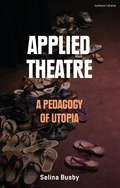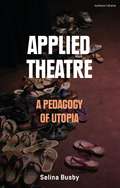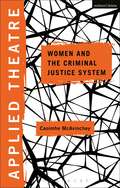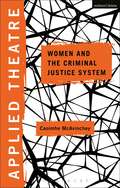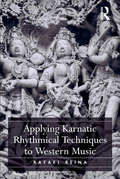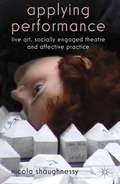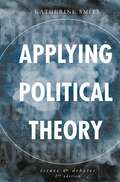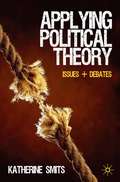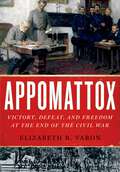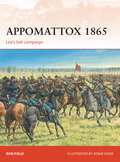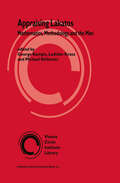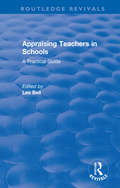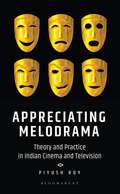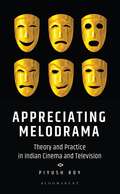- Table View
- List View
Applied Theatre: A Pedagogy of Utopia
by Selina BusbyApplied Theatre is a widely accepted term to describe a set of practices that encompass community, social and participatory theatre making. It is an area of performance practice that is flourishing within international contexts and communities. This book offers a critical consideration of long-term applied and participatory theatre projects. In doing so it is a timely analysis of the concepts that inform applied theatre and argues that a number of concepts that form cornerstones of the discipline, have become shibboleths in applied theatre thinking, practice and teaching. The book problematises some of these key concepts, specifically regarding change and transformation, safe spaces, impact, exit strategies, ethical practice, process versus product and the concept of the applied theatre practitioner tool kit. Busby analyses applied theatre projects in India, Malta, New Zealand, the USA and the UK to consider her key question: is the 21st century the end for applied theatre as it was understood to function at the end of the previous century? Drawing on 20 years of practice in prisons, youth theatres and with street and slum-dwellers, this book focuses on long-term interventions that raise troubling questions about applied theatre, cultural colonialism and power, while arguing that community or participatory theatre conversely has the potential to generate a resilient sense of optimism, or what Busby terms a 'nebulous utopia'.
Applied Theatre: A Pedagogy of Utopia
by Selina BusbyApplied Theatre is a widely accepted term to describe a set of practices that encompass community, social and participatory theatre making. It is an area of performance practice that is flourishing within international contexts and communities. This book offers a critical consideration of long-term applied and participatory theatre projects. In doing so it is a timely analysis of the concepts that inform applied theatre and argues that a number of concepts that form cornerstones of the discipline, have become shibboleths in applied theatre thinking, practice and teaching. The book problematises some of these key concepts, specifically regarding change and transformation, safe spaces, impact, exit strategies, ethical practice, process versus product and the concept of the applied theatre practitioner tool kit. Busby analyses applied theatre projects in India, Malta, New Zealand, the USA and the UK to consider her key question: is the 21st century the end for applied theatre as it was understood to function at the end of the previous century? Drawing on 20 years of practice in prisons, youth theatres and with street and slum-dwellers, this book focuses on long-term interventions that raise troubling questions about applied theatre, cultural colonialism and power, while arguing that community or participatory theatre conversely has the potential to generate a resilient sense of optimism, or what Busby terms a 'nebulous utopia'.
The Applied Theatre Reader
by Tim Prentki Sheila PrestonThe Applied Theatre Readeris the first book to bring together new case studies of practice by leading practitioners and academics in the field and beyond, with classic source texts from writers such as Noam Chomsky, bell hooks, Mikhail Bakhtin, Augusto Boal, and Chantal Mouffe. This book divides the field into key themes, inviting critical interrogation of issues in applied theatre whilst also acknowledging the multi-disciplinary nature of its subject. It crosses fields such as: theatre in educational settings prison theatre community performance theatre in conflict resolution and reconciliation interventionist theatre theatre for development. This collection of critical thought and practice is essential to those studying or participating in the performing arts as a means for positive change.
Applied Theatre Reader (PDF)
by Tim Prentki Sheila PrestonThe Applied Theatre Reader is the first book to bring together new case studies of practice by leading practitioners and academics in the field and beyond, with classic source texts from writers such as Noam Chomsky, bell hooks, Mikhail Bakhtin, Augusto Boal, and Chantal Mouffe. This book divides the field into key themes, inviting critical interrogation of issues in applied theatre whilst also acknowledging the multi-disciplinary nature of its subject. It crosses fields such as: theatre in educational settings prison theatre community performance theatre in conflict resolution and reconciliation interventionist theatre theatre for development. This collection of critical thought and practice is essential to those studying or participating in the performing arts as a means for positive change.
Applied Theatre: Women and the Criminal Justice System (Applied Theatre)
by Caoimhe McAvincheyApplied Theatre: Women and the Criminal Justice System offers unprecedented access to international theatre and performance practice in carceral contexts and the material and political conditions that shape this work. Each of the twelve essays and interviews by international practitioners and scholars reveal a panoply of practice: from cross-arts projects shaped by autobiographical narratives through to fantasy-informed cabaret; from radio plays to film; from popular participatory performance to work staged in commercial theatres. Extracts of performance texts, developed with Clean Break theatre company, are interwoven through the collection.Television and film images of women in prison are repeatedly painted from a limited palette of stereotypes – 'bad girls', 'monsters', 'babes behind bars'. To attend to theatre with and about women with experience of the criminal justice system is to attend to intersectional injustices that shape women's criminalization and the personal and political implications of this. The theatre and performance practices in this collection disrupt, expand and reframe representational vocabularies of criminalized women for audiences within and beyond prison walls. They expose the role of incarceration as a mechanism of state punishment, the impact of neoliberalism on ideologies of punishment and the inequalities and violence that shape the lives of many incarcerated women. In a context where criminalized women are often dismissed as unreliable or untrustworthy, the collection engages with theatre practices which facilitate an economy of credibility, where women with experience of the criminal justice system are represented as expert witnesses.
Applied Theatre: Women and the Criminal Justice System (Applied Theatre)
by Caoimhe McAvincheyApplied Theatre: Women and the Criminal Justice System offers unprecedented access to international theatre and performance practice in carceral contexts and the material and political conditions that shape this work. Each of the twelve essays and interviews by international practitioners and scholars reveal a panoply of practice: from cross-arts projects shaped by autobiographical narratives through to fantasy-informed cabaret; from radio plays to film; from popular participatory performance to work staged in commercial theatres. Extracts of performance texts, developed with Clean Break theatre company, are interwoven through the collection.Television and film images of women in prison are repeatedly painted from a limited palette of stereotypes – 'bad girls', 'monsters', 'babes behind bars'. To attend to theatre with and about women with experience of the criminal justice system is to attend to intersectional injustices that shape women's criminalization and the personal and political implications of this. The theatre and performance practices in this collection disrupt, expand and reframe representational vocabularies of criminalized women for audiences within and beyond prison walls. They expose the role of incarceration as a mechanism of state punishment, the impact of neoliberalism on ideologies of punishment and the inequalities and violence that shape the lives of many incarcerated women. In a context where criminalized women are often dismissed as unreliable or untrustworthy, the collection engages with theatre practices which facilitate an economy of credibility, where women with experience of the criminal justice system are represented as expert witnesses.
Applying Karnatic Rhythmical Techniques to Western Music
by Rafael ReinaMost classical musicians, whether in orchestral or ensemble situations, will have to face a piece by composers such as Ligeti, Messiaen, Varèse or Xenakis, while improvisers face music influenced by Dave Holland, Steve Coleman, Aka Moon, Weather Report, Irakere or elements from the Balkans, India, Africa or Cuba. Rafael Reina argues that today’s music demands a new approach to rhythmical training, a training that will provide musicians with the necessary tools to face, with accuracy, more varied and complex rhythmical concepts, while keeping the emotional content. Reina uses the architecture of the South Indian Karnatic rhythmical system to enhance and radically change the teaching of rhythmical solfege at a higher education level and demonstrates how this learning can influence the creation and interpretation of complex contemporary classical and jazz music. The book is designed for classical and jazz performers as well as creators, be they composers or improvisers, and is a clear and complete guide that will enable future solfege teachers and students to use these techniques and their methodology to greatly improve their rhythmical skills. An accompanying website of audio examples helps to explain each technique. For examples of composed and improvised pieces by students who have studied this book, as well as concerts by highly acclaimed karnatic musicians, please copy this link to your browser: http://www.contemporary-music-through-non-western-techniques.com/pages/1587-video-recordings
Applying Karnatic Rhythmical Techniques to Western Music
by Rafael ReinaMost classical musicians, whether in orchestral or ensemble situations, will have to face a piece by composers such as Ligeti, Messiaen, Varèse or Xenakis, while improvisers face music influenced by Dave Holland, Steve Coleman, Aka Moon, Weather Report, Irakere or elements from the Balkans, India, Africa or Cuba. Rafael Reina argues that today’s music demands a new approach to rhythmical training, a training that will provide musicians with the necessary tools to face, with accuracy, more varied and complex rhythmical concepts, while keeping the emotional content. Reina uses the architecture of the South Indian Karnatic rhythmical system to enhance and radically change the teaching of rhythmical solfege at a higher education level and demonstrates how this learning can influence the creation and interpretation of complex contemporary classical and jazz music. The book is designed for classical and jazz performers as well as creators, be they composers or improvisers, and is a clear and complete guide that will enable future solfege teachers and students to use these techniques and their methodology to greatly improve their rhythmical skills. An accompanying website of audio examples helps to explain each technique. For examples of composed and improvised pieces by students who have studied this book, as well as concerts by highly acclaimed karnatic musicians, please copy this link to your browser: http://www.contemporary-music-through-non-western-techniques.com/pages/1587-video-recordings
Applying Performance: Live Art, Socially Engaged Theatre and Affective Practice
by N. ShaughnessyThis book draws upon cognitive and affect theory to examine applications of contemporary performance practices in educational, social and community contexts. The writing is situated in the spaces between making and performance, exploring the processes of creating work defined variously as collaborative, participatory and socially engaged.
Applying Political Theory: Issues and Debates
by Katherine SmitsFully revised and extended, the new edition of this innovative and engaging textbook introduces the central elements of political theory from an applied perspective. Focusing on 12 high-profile contemporary social and political case studies, both domestic and global, this text shows how political theory illuminates and helps makes sense of important debates in public life. This is the perfect introduction for students interested in how political theory can be used to help us solve the political questions of our time, whether at a beginner’s level, or building upon an introduction to theories and concepts.
Applying Political Theory: Issues and Debates
by Katherine SmitsHow can political theory help us understand and solve the political questions of our time? This introduction to political theory illuminates its relevance and applicability and clarifies what is at stake in debates over welfare; terrorism and civil liberties; minority rights; abortion and euthanasia; freedom of speech and a range of other issues.
Applying Rawls in the Twenty-First Century: Race, Gender, the Drug War, and the Right to Die
by M. CarcieriJohn Rawls was the most influential political thinker of the twentieth century. This book applies his theory of justice to four perennial matters of concern that remain contested in the twenty-first century. Drawing surprising implications, this book deepens our understanding of these issues and points the way toward rational, just policy reform.
Applying Relational Sociology: Relations, Networks, and Society
by Fran�ois D�pelteau and Christopher PowellEdited by François Depelteau and Christopher Powell, this volume and its companion, Conceptualizing Relational Sociology: Ontological and Theoretical Issues, addresses fundamental questions about what relational sociology is and how it works.
Applying Risk-Sharing Finance for Economic Development: Lessons from Germany (Political Economy of Islam)
by Putri Swastika Abbas MirakhorThis book examines the application of risk-sharing finance as a national economic policy in history and how it stimulated economic recovery during a short period in Germany between 1933 and 1935. Economic history indicates that risk-sharing instruments have promoted socio-economic development in many parts of the world while risk-shifting methods have imposed huge socio-economic costs on many nations, leading to debt slavery on individual members. This book highlights lessons to be learned from history and argues that risk-sharing is a powerful tool for generating rapid economic recovery and resumption of growth.
Appointment in Japan: Memories of Sixty Years (Bloomsbury Academic Collections: Japan)
by George Cyril AllenG.C. Allen's first job took him to Japan in 1922, and he continued to visit the country and to study its culture up to his death in July 1982. Appointment in Japan is both a historical record of Japan in the 1920s and a study of the changes which have taken place during a critical sixty-year period.First published in 1983, this title is part of the Bloomsbury Academic Collections series.
Appomattox: Victory, Defeat, and Freedom at the End of the Civil War
by Elizabeth R. VaronWinner, Library of Virginia Literary Award for Nonfiction Winner, Eugene Feit Award in Civil War Studies, New York Military Affairs Symposium Winner of the Dan and Marilyn Laney Prize of the Austin Civil War Round Table Finalist, Jefferson Davis Award of the Museum of the Confederacy Best Books of 2014, Civil War Monitor 6 Civil War Books to Read Now, Diane Rehm Show, NPR Lee's surrender to Grant at Appomattox Court House evokes a highly gratifying image in the popular mind -- it was, many believe, a moment that transcended politics, a moment of healing, a moment of patriotism untainted by ideology. But as Elizabeth Varon reveals in this vividly narrated history, this rosy image conceals a seething debate over precisely what the surrender meant and what kind of nation would emerge from war. The combatants in that debate included the iconic Lee and Grant, but they also included a cast of characters previously overlooked, who brought their own understanding of the war's causes, consequences, and meaning. In Appomattox, Varon deftly captures the events swirling around that well remembered-but not well understood-moment when the Civil War ended. She expertly depicts the final battles in Virginia, when Grant's troops surrounded Lee's half-starved army, the meeting of the generals at the McLean House, and the shocked reaction as news of the surrender spread like an electric charge throughout the nation. But as Varon shows, the ink had hardly dried before both sides launched a bitter debate over the meaning of the war and the nation's future. For Grant, and for most in the North, the Union victory was one of right over wrong, a vindication of free society; for many African Americans, the surrender marked the dawn of freedom itself. Lee, in contrast, believed that the Union victory was one of might over right: the vast impersonal Northern war machine had worn down a valorous and unbowed South. Lee was committed to peace, but committed, too, to the restoration of the South's political power within the Union and the perpetuation of white supremacy. These two competing visions of the war's end paved the way not only for Southern resistance to reconstruction but also our ongoing debates on the Civil War, 150 years later. Did America's best days lie in the past or in the future? For Lee, it was the past, the era of the founding generation. For Grant, it was the future, represented by Northern moral and material progress. They held, in the end, two opposite views of the direction of the country-and of the meaning of the war that had changed that country forever.
Appomattox: Victory, Defeat, and Freedom at the End of the Civil War
by Elizabeth R. VaronWinner, Library of Virginia Literary Award for Nonfiction Winner, Eugene Feit Award in Civil War Studies, New York Military Affairs Symposium Winner of the Dan and Marilyn Laney Prize of the Austin Civil War Round Table Finalist, Jefferson Davis Award of the Museum of the Confederacy Best Books of 2014, Civil War Monitor 6 Civil War Books to Read Now, Diane Rehm Show, NPR Lee's surrender to Grant at Appomattox Court House evokes a highly gratifying image in the popular mind -- it was, many believe, a moment that transcended politics, a moment of healing, a moment of patriotism untainted by ideology. But as Elizabeth Varon reveals in this vividly narrated history, this rosy image conceals a seething debate over precisely what the surrender meant and what kind of nation would emerge from war. The combatants in that debate included the iconic Lee and Grant, but they also included a cast of characters previously overlooked, who brought their own understanding of the war's causes, consequences, and meaning. In Appomattox, Varon deftly captures the events swirling around that well remembered-but not well understood-moment when the Civil War ended. She expertly depicts the final battles in Virginia, when Grant's troops surrounded Lee's half-starved army, the meeting of the generals at the McLean House, and the shocked reaction as news of the surrender spread like an electric charge throughout the nation. But as Varon shows, the ink had hardly dried before both sides launched a bitter debate over the meaning of the war and the nation's future. For Grant, and for most in the North, the Union victory was one of right over wrong, a vindication of free society; for many African Americans, the surrender marked the dawn of freedom itself. Lee, in contrast, believed that the Union victory was one of might over right: the vast impersonal Northern war machine had worn down a valorous and unbowed South. Lee was committed to peace, but committed, too, to the restoration of the South's political power within the Union and the perpetuation of white supremacy. These two competing visions of the war's end paved the way not only for Southern resistance to reconstruction but also our ongoing debates on the Civil War, 150 years later. Did America's best days lie in the past or in the future? For Lee, it was the past, the era of the founding generation. For Grant, it was the future, represented by Northern moral and material progress. They held, in the end, two opposite views of the direction of the country-and of the meaning of the war that had changed that country forever.
Appomattox 1865: Lee’s last campaign (Campaign)
by Ron Field Mr Adam HookFrom an internationally renowned expert on US history, this highly illustrated title details the curtain-closing campaign of the American Civil War in the East. Ulysses S Grant's Army of the Potomac and Robert E Lee's Army of Northern Virginia faced up to one another one last time, resulting in Lee conducting a desperate series of withdrawals and retreats down the line of the Richmond and Danville Railroad, hoping to join forces with General Joseph E. Johnston's Army of Tennessee. This book, with informative full-colour illustrations and maps, tells the full story of the skirmishes and pursuits that led directly to Lee's surrender, as his frantic efforts to extricate his forces from ever more perilous positions became increasingly untenable.
Appomattox 1865: Lee’s last campaign (Campaign)
by Adam Hook Ron FieldFrom an internationally renowned expert on US history, this highly illustrated title details the curtain-closing campaign of the American Civil War in the East. Ulysses S Grant's Army of the Potomac and Robert E Lee's Army of Northern Virginia faced up to one another one last time, resulting in Lee conducting a desperate series of withdrawals and retreats down the line of the Richmond and Danville Railroad, hoping to join forces with General Joseph E. Johnston's Army of Tennessee. This book, with informative full-colour illustrations and maps, tells the full story of the skirmishes and pursuits that led directly to Lee's surrender, as his frantic efforts to extricate his forces from ever more perilous positions became increasingly untenable.
An Appraisal of the 1950 Census Income Data, Volume 23: Studies in Income and Wealth (PDF)
by National Bureau of Economic Research Gerald GarveyThis volume, from the 1956 Conference, deals with the nature, reliability, and the uses of the income data included in the 1950 census. It contrasts this data with income information from other sources—field surveys, and administrative records of government regulatory, fiscal, and social security agencies. Another group of papers deals with substantive findings based on income data. Of three papers of a more general nature, one surveys the frontiers of size distribution research, another builds a bridge between the census data and other income data, and a third provides an historical review of income questions in census surveys.Originally published in 1958.The Princeton Legacy Library uses the latest print-on-demand technology to again make available previously out-of-print books from the distinguished backlist of Princeton University Press. These editions preserve the original texts of these important books while presenting them in durable paperback and hardcover editions. The goal of the Princeton Legacy Library is to vastly increase access to the rich scholarly heritage found in the thousands of books published by Princeton University Press since its founding in 1905.
Appraising Lakatos: Mathematics, Methodology, and the Man (Vienna Circle Institute Library #1)
by Friedrich StadlerImre Lakatos (1922-1974) was one of the protagonists in shaping the "new philosophy of science". More than 25 years after his untimely death, it is time for a critical re-evaluation of his ideas. His main theme of locating rationality within the scientific process appears even more compelling today, after many historical case studies have revealed the cultural and societal elements within scientific practices. Recently there has been, above all, an increasing interest in Lakatos' philosophy of mathematics, which emphasises heuristics and mathematical practice over logical justification. But suitable modifications of his approach are called for in order to make it applicable to modern axiomatised theories. Pioneering historical research in England and Hungary has unearthed hitherto unknown facts about Lakatos' personal life, his wartime activities and his involvement in the political developments of post-war Europe. From a communist activist committed to Györgyi Lukács' thinking, Lakatos developed into a staunch anti-Marxist who found his intellectual background in Popper's critical rationalism. The volume also publishes for the first time a part of his Debrecen Ph.D. thesis and it is concluded by a bibliography of his Hungarian writings.
Appraising Teachers in Schools: A Practical Guide (Routledge Revivals)
by Les BellOriginally published in 1988, Appraising Teachers in Schools considers and provides advice on the introduction of staff appraisal in schools. Following the publication of the 1987 Pay and Conditions of Employment and written by contributors with practical experience of introducing staff appraisal into schools, the book provides guidance on the introduction of staff appraisal across a range of schools; outlines a planning process for the establishment of staff appraisal; and offers suggestions for how to prepare for the appraisal process. It covers both primary and secondary education in a variety of larger and smaller schools. Appraising Teachers in Schools will appeal to those with an interest in the history of education and the history of staff appraisal in schools in particular.
Appraising Teachers in Schools: A Practical Guide (Routledge Revivals)
by Les BellOriginally published in 1988, Appraising Teachers in Schools considers and provides advice on the introduction of staff appraisal in schools. Following the publication of the 1987 Pay and Conditions of Employment and written by contributors with practical experience of introducing staff appraisal into schools, the book provides guidance on the introduction of staff appraisal across a range of schools; outlines a planning process for the establishment of staff appraisal; and offers suggestions for how to prepare for the appraisal process. It covers both primary and secondary education in a variety of larger and smaller schools. Appraising Teachers in Schools will appeal to those with an interest in the history of education and the history of staff appraisal in schools in particular.
Appreciating Melodrama: Theory and Practice in Indian Cinema and Television
by Piyush RoyAppreciating Melodrama: Theory and Practice in Indian Cinema and Television seeks to identify and appreciate the continual influence of the ancient Sanskrit drama treatise, the Natyashastra, and its theory of aesthetics, the rasa theory, on the unique narrative attributes of Indian cinema.This volume of work critically engages with a representative sample of landmark films from 100 years of Indian film history across genres, categories, regions and languages. This is the first time a case study-based rigorous academic review of popular Indian cinema is done using the Indian aesthetic appreciation theory of rasa (affect/emotion). It proposes a theoretical model for film appreciation, especially for content made in the melodramatic genre, and challenges existing First World/Euro-American film criticism canons and notions that privilege cinematic 'realism' over other narrative forms, which will generate passionate debates for and against its propositions in future studies and research on films.This is a valuable academic reference book for students of film and theatre, world cinema and Indian cinema studies, South Asian studies and culture, Indology and the 'Sociology of Cinema' studies. It is a must-have reference text in the curriculum of both practical-oriented acting schools, as well as courses and modules focusing on a theoretical study of cinema, such as film criticism and appreciation, and the history of movies and performance studies.
Appreciating Melodrama: Theory and Practice in Indian Cinema and Television
by Piyush RoyAppreciating Melodrama: Theory and Practice in Indian Cinema and Television seeks to identify and appreciate the continual influence of the ancient Sanskrit drama treatise, the Natyashastra, and its theory of aesthetics, the rasa theory, on the unique narrative attributes of Indian cinema.This volume of work critically engages with a representative sample of landmark films from 100 years of Indian film history across genres, categories, regions and languages. This is the first time a case study-based rigorous academic review of popular Indian cinema is done using the Indian aesthetic appreciation theory of rasa (affect/emotion). It proposes a theoretical model for film appreciation, especially for content made in the melodramatic genre, and challenges existing First World/Euro-American film criticism canons and notions that privilege cinematic 'realism' over other narrative forms, which will generate passionate debates for and against its propositions in future studies and research on films.This is a valuable academic reference book for students of film and theatre, world cinema and Indian cinema studies, South Asian studies and culture, Indology and the 'Sociology of Cinema' studies. It is a must-have reference text in the curriculum of both practical-oriented acting schools, as well as courses and modules focusing on a theoretical study of cinema, such as film criticism and appreciation, and the history of movies and performance studies.
